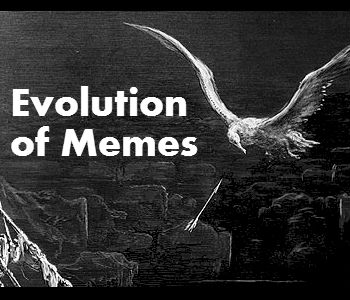For over two years I had shared many Internet memes on the Occupy Wall Street page I had administered. More than any other form of content, memes had proven to be the clear winner in the share-ability department in an age of real-time revolution. Internet memes are those images (or pictures, hashtags, websites, hyperlinks, video, etc.) often adorned with a message which spread from person to person. They have evolved to become important tools in the activist’s toolkit, too.
 Richard Dawkins, the famed author, atheist, and Oxford professor, coined the word in his 1976 book The Selfish Gene to describe how Darwinian principles might be understood through the replication of ideas instead of genes:
Richard Dawkins, the famed author, atheist, and Oxford professor, coined the word in his 1976 book The Selfish Gene to describe how Darwinian principles might be understood through the replication of ideas instead of genes:
“Examples of memes are tunes, ideas, catch-phrases, clothes fashions, ways of making pots or of building arches. Just as genes propagate themselves in the gene pool by leaping from body to body via sperms or eggs, so memes propagate themselves in the meme pool by leaping from brain to brain via a process which, in the broad sense, can be called imitation.”
I stumbled early onto the fact that the easiest way to pump-up the stats on your Facebook page was to simply post a meme. I could do this by one of two ways by simply using the share feature provided by Facebook, or I could go through the steps of downloading the meme and then uploading to my page if I felt the meme to be of particular importance and wanted people to know that my page was the new “primary” source.
Over time, I came to appreciate memes containing impactful images with a brief textual message which expressed a strong opinion supported by factual evidence accompanied by a source. Sources often took the form of a featured URL or a quote from a public figure. A precious few memes I had posted resulted in several thousand Facebook shares and had audience reaches in excess of 100,000 users. Several archived examples can be found here.

I tried my hand at creating my own memes if I had a particular message I wanted to share, but I usually left it to the pros, people like Scott Cahoon from Too Big Has Failed. His website is geared towards exposing the crimes of some of Wall Street’s largest banks and what the public response should be, and his memes are constructed to suit the purpose. Cahoon had been a contributor to my Facebook page and has been kind enough to answer a few of my questions about the memes he’s created.
“We use memes to pique viewers’ interest in our site, with the hope that they’ll want to read our more complex (and worthwhile) work,” Cahoon wrote. “To that end we’ve written an ebook that illuminates many of the details about the big banks that are impossible to convey in a single meme or blog post. Our hope, then, is that a simple anger-inducing meme will lead people to want to more fully understand the issue, which will in turn lead them to make better financial decisions. A meme is just the doorway to something more complex and interesting.”
This strategy rings true with my own experiences in social media as a digital activist; similarly, I’d been guided by my personal motto, to inform and to incite. If done correctly and with a little luck, an activist stands to reach many thousands of concerned individuals through the use of memes.

“Overall, we’ve had more than 20,000 shares and more than one million views, according to Facebook analytics,” Cahoon wrote. “Our most successful meme so far summarized a news story about Bank of America giving employees gift cards to foreclose on their own customers. It had 2,250 shares, which is pretty good for a page with only 2,630 fans.”
The luck portion of the equation usually has to do with timing. Memes everywhere that appear right after a much publicized event or news story stand a better chance of going viral.
Cahoon continues, “I think the reason that meme got shared so much is that it was timely, anger-inducing, and simple. Those three qualities are essential when it comes to online activism. You’ve got to find something that fits the zeitgeist, makes people feel anger, and simplifies an issue. That’s the secret. But it’s a very hard thing to get all three things right in one post.”
Anyone with a little experience with basic photo editing software is capable of making their own Internet memes. Here are three steps from the admin of Too Big Has Failed:
1) Use the advanced search feature on a site like Flickr to find a stellar Creative Commons picture—one that doesn’t have any restrictions on its use.
2) Type text over the picture, using a good font (FontSquirrel.com has several nice free options).
3) Tweak the design to get a high contrast between the picture and the font, and to keep it looking as simple and interesting as possible.
Read more: https://www.digitaljournal.com/article/361136#ixzz2lK1edUkU

Leave a Reply